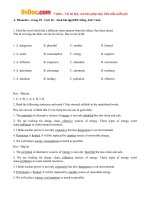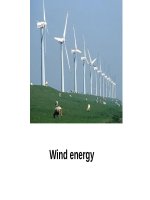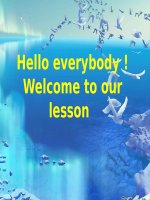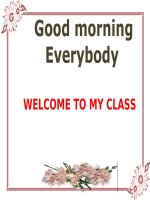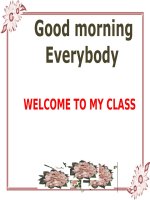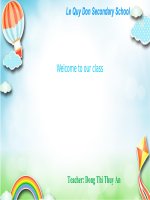Unit 10 Sources of Energy Lesson 4 Communication
Bạn đang xem bản rút gọn của tài liệu. Xem và tải ngay bản đầy đủ của tài liệu tại đây (1.78 MB, 20 trang )
Dai Dong Thanh Secondary school
Student:Cao Thi Hong Loan
Game: lucky number
•
•
•
•
Luật chơi:
Một bức tranh có 4 miếng ghép
Mỗi miếng ghép tương ứng với một câu hỏi
Mỗi câu hỏi được trả lời sẽ mở ra một miếng
ghép của bức hình.
Game: lucky number
1.What is a carbon
footprint?
1
2
Carbon
3
footprint
4
Carbon footprint is
about the negative
effect we have on the
environment.
2.How big is your
carbon footprint ?
1.It is name’s energy
•
•
•
•
•
It is non-renewable.
Using it is polluting and harmful.
It has many in Quang Ninh province.
It is black.
Answer:It is coal
2. it is name’s energy
• It is renewable.
• It is abundant, clean and safe. But it is
expensive
• It puts on the roof at home to catch the
sunshine.
• Answer:It is solar
This is an activity of students when
they go to school.
• How do students go to school?
• Answer: ride a bike
Lucky number
Unit 10: sources of energy
i. vocabulary
•
•
•
•
To take a shower
Ride a bike
Public transport
A hand fan
:Tắm vịi hoa sen
:Đạp xe đạp
:Phương tiện cơng cộng
:Quạt làm bằng tay
How big is your carbon footprint ?
Activity 1: Answer the questions below with a number from 1 to 4 .
always =1
sometimes=3
often =2
never =4
1. Answer the question below with a
nummer from 1 to 4
1. Take showers instead of baths
2. Walk or ride a bike when
travelling short distances
3. Use public transport when
travelling long distances
4. Use a hang fan to keep cool in
the summer
5. Use low energy light bulbs
6.Turn off the lights when leaving a
room or going to bed
7.Only use as much water as you
need
8.Only use a little electricity at
home
9.Use biogas for cooking at home
10.Go to school by bike
A: How often do you take showers instead of baths ?
never
often
B: I sometime
always take showers instead of baths
Activities
1. take showers instead of baths ?
2. walk or ride a bike when travelling short distances?
3. use public transport when travelling long distances?
4. use a hand fan to keep cool in summer ?
5. use low energy light bulbs ?
6. turn off the lights when leaving a room ?
7. only use as much water as you need?
8. only use a little electricity at home?
9. use biogas for cooking at home?
10. go to school by bike?
Total score:
Name
How big is your carbon footprint ?
Activity 2: Work in pairs. Add up each other’s answers, and look up
the score below.Then explain how well your partner saves energy.
Score
10 - 20
Score
21 - 30
Score
31 - 40
Your footprint is small.You are really
environmentally friendly .
Your footprint is quite small.
Remember to care about and respect,
the world around you .
Your footprint is quite big.You do
some things to save energy, but
there’s always room for
improvement.
Look at the table, answer the
question
what is your total score?
•In the group, who gets the highest score?
•In the group, who gets the lowest score?
How big is your carbon footprint ?
Activity 3: Talk about your partner’s carbon footprint
to your group. Use the following prompts.
. my partner’s carbon footprint is ……
. he/she is considerate because ……
. he/she could try harder to ………
. by …… in the future, he/she can help to ………
Activity 3: Talk about your partner’s carbon footprint
to your group. Use the following prompts.
Example1- Student gets score 31- 40:
My partner’s carbon footprint is……..
big He is considerate
because…………….……………He
could try harder to
he uses lots of baths
…………………………………
use showers instead of baths By…………………………...…
reducing the use of baths ,
save energy
he can help to………………
Example 2 - Student gets score 10- 20:
My partner’s carbon footprint is ……….because
small
recycles the products she uses and she
she……………………………………………………
doing this
….…………………………………
usually
goes to school by bike By…………...,
save energy
she can help to………………..
Discussion:
What should you do at school as well
as at home to be environmentally
friendly ?
Home work
Learn by heart the new word
Do exercise in work book
Prepare for next lesson: skill 1
